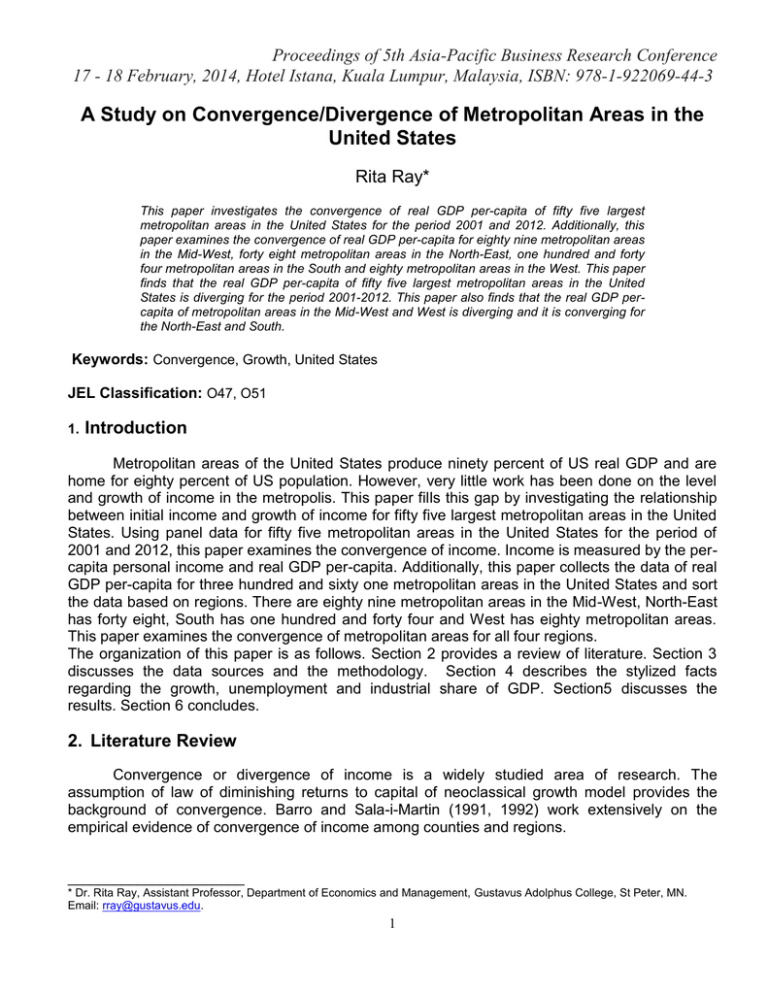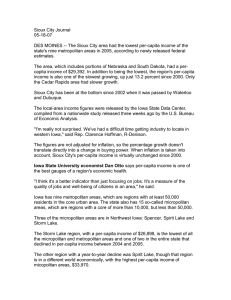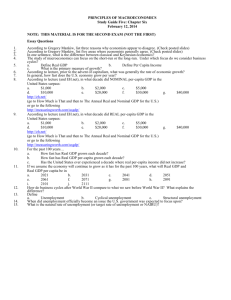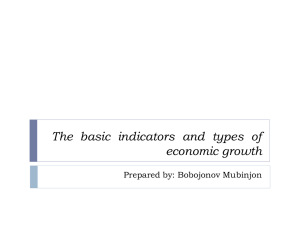Proceedings of 5th Asia-Pacific Business Research Conference
advertisement

Proceedings of 5th Asia-Pacific Business Research Conference 17 - 18 February, 2014, Hotel Istana, Kuala Lumpur, Malaysia, ISBN: 978-1-922069-44-3 A Study on Convergence/Divergence of Metropolitan Areas in the United States Rita Ray* This paper investigates the convergence of real GDP per-capita of fifty five largest metropolitan areas in the United States for the period 2001 and 2012. Additionally, this paper examines the convergence of real GDP per-capita for eighty nine metropolitan areas in the Mid-West, forty eight metropolitan areas in the North-East, one hundred and forty four metropolitan areas in the South and eighty metropolitan areas in the West. This paper finds that the real GDP per-capita of fifty five largest metropolitan areas in the United States is diverging for the period 2001-2012. This paper also finds that the real GDP percapita of metropolitan areas in the Mid-West and West is diverging and it is converging for the North-East and South. Keywords: Convergence, Growth, United States JEL Classification: O47, O51 1. Introduction Metropolitan areas of the United States produce ninety percent of US real GDP and are home for eighty percent of US population. However, very little work has been done on the level and growth of income in the metropolis. This paper fills this gap by investigating the relationship between initial income and growth of income for fifty five largest metropolitan areas in the United States. Using panel data for fifty five metropolitan areas in the United States for the period of 2001 and 2012, this paper examines the convergence of income. Income is measured by the percapita personal income and real GDP per-capita. Additionally, this paper collects the data of real GDP per-capita for three hundred and sixty one metropolitan areas in the United States and sort the data based on regions. There are eighty nine metropolitan areas in the Mid-West, North-East has forty eight, South has one hundred and forty four and West has eighty metropolitan areas. This paper examines the convergence of metropolitan areas for all four regions. The organization of this paper is as follows. Section 2 provides a review of literature. Section 3 discusses the data sources and the methodology. Section 4 describes the stylized facts regarding the growth, unemployment and industrial share of GDP. Section5 discusses the results. Section 6 concludes. 2. Literature Review Convergence or divergence of income is a widely studied area of research. The assumption of law of diminishing returns to capital of neoclassical growth model provides the background of convergence. Barro and Sala-i-Martin (1991, 1992) work extensively on the empirical evidence of convergence of income among counties and regions. _______________________ * Dr. Rita Ray, Assistant Professor, Department of Economics and Management, Gustavus Adolphus College, St Peter, MN. Email: rray@gustavus.edu. 1 Proceedings of 5th Asia-Pacific Business Research Conference 17 - 18 February, 2014, Hotel Istana, Kuala Lumpur, Malaysia, ISBN: 978-1-922069-44-3 Barro and Sala-i-Martin (1991) examine the association between per-capita personal income and its annual growth between 1880 and 1988 for forty eight American states. They also investigate the connection between per-capita Gross State Product and its annual growth between 1963 and 1986 for forty eight American states. They extend their analysis on Gross Domestic Product and its annual growth rate for seventy three regions of Western Europe between 1950 and 1985. They find the evidence of convergence among American states and the regions of Western Europe. Barro and Sala-i-Martin’s 1992 (I) paper describe the convergence of per-capita personal income and per-capita Gross State Product of forty eight American states between 1880 – 1988 and 1963 – 1986 respectively. The paper additionally examines the relationship between per-capita GDP and its annual growth for ninety eight countries between 1960 and 1985. They find the evidence of divergence across countries. However, when they hold primary and secondary school enrollment rates and the average ratio of government consumption expenditure to GDP as constants, they find the evidence of convergence. Barro and Sala-i-Martin (1992, II) find the evidence of convergence of per-capita income for forty seven Japanese prefectures between the period 1930 and 1990. Convergence of income is investigated and evident for Australasia (Cashin, 1995), Bangladesh (Hossain, 2000), Greece (Petrakos and Saratsis, 2000), Sweden (Persson, 1997). Cashin and Sahay (1995) find the evidence of regional convergence of per-capita net state domestic product among Indian states. However, Marjit and Mitra (1996) and Ghosh, Margit and Neogi (1998) find the evidence of divergence of per-capita net state domestic product among Indian states. Yao and Weeks (2000) examine the income convergence in China between the time period 1953 and 1997. They find the evidence of divergence of income between coastal provinces and interior provinces of China between 1978 and 1997 due to the technological growth rate disparity. 3. Data and Methodology 3.1 Data Sources I collect the data on real GDP per-capita for metropolitan areas for all metropolitan areas in the United Sates and industry share of real GDP for fifty five largest metropolitan areas in the United States from the Bureau of Economic Analysis. I collect the data on unemployment rate from the Bureau of Labor Statistics. 3.2 Methodology To investigate the convergence of real GDP per-capita of metropolitan areas in the United States, I use the following model: I subtract and, from equation (1) and get equation (2). is the real GDP per-capita in metropolitan area i at year t. ) and are independent of each other and among themselves. is the annual growth rate of real GDP per-capita and annual in metropolitan area i at year t respectively. represents convergence. I use the GMM estimator for dynamic panel data model proposed by Holtz-Eakin, Newey and Rosen (1988) and Arellano and Bond (1991) to estimate equation (1). The lagged dependent variable on the right hand side makes the regressors endogenous (since is a function of so is also correlated with ). Metropolis-specific omitted variables also make the regressors endogenous. The GMM estimator takes the regressors as endogenous and generates additional instruments by utilizing the orthogonality condition between the lagged values of the regressors and the disturbance term 2 Proceedings of 5th Asia-Pacific Business Research Conference 17 - 18 February, 2014, Hotel Istana, Kuala Lumpur, Malaysia, ISBN: 978-1-922069-44-3 4. Stylized Facts Table 1 provides some facts regarding the rank and change of rank of real GDP per-capita and unemployment rates for the fifty five largest metropolitan areas in the United States between the period 2001-2007 and 2008-2012. Eight metropolitan areas are able to keep their rank within top ten with respect to real GDP per-capita between 2001-2007 and 2008-2012. This number is same for bottom ten metropolitan areas. Twenty two metropolitan areas are able to improve their rank, for seven metropolitan areas it is same and the rank deteriorates for twenty six metropolitan areas between 2001-2007 and 20082012. For unemployment rates only four metropolitan areas are in bottom ten between 2001-2007 and 2008-2012. This number is two for top ten. Twenty nine metropolitan areas are able to improve their rank, for only one metropolitan area it is same and the rank deteriorates for twenty five metropolitan areas between 2001-2007 and 2008-2012. Number of Number of Number of Number of Number of Metropolitan Metropolitan Metropolitan Metropolitan Metropolitan Areas Areas Areas whose Areas whose Areas whose belongs to belongs to Rank Rank remains Rank Variable Top Ten Bottom Ten Improves Same Deteriorates between between between between between 2001-2007 2001-2007 2001-2007 2001-2007 2001-2007 and 2008and 2008and 2008and 2008and 20082012 2012 2012 2012 2012 Real GDP 8 8 22 7 26 Per-Capita Unemployment 2 4 29 1 25 Rate Table 1 Table 2 compares the growth rate of metropolitan area with the regional growth rate for the fifty five largest metropolitan areas between the period 2001-2007 and 2008-2012. There are fourteen metropolitan areas in the Mid-West region. Two metropolitan areas have higher growth rate compare to the growth rate of Mid-West in the period 2001-2007. However, none of the metropolitan area has higher growth rate compare to the Mid-Western growth rate in 2008-2012. There are nine metropolitan areas in the NorthEast region. Five metropolitan areas have higher growth rate compare to the growth rate of North-East in the period 2001-2007 and this number is four for the period 2008-2012. There are twenty two metropolitan areas in the South. Nine metropolitan areas have higher growth rate compare to the growth rate of South for both the period of 2001-2007 and 2008-2012. There are en metropolitan areas in the West. Eight metropolitan areas have higher growth rate compare to the growth rate of West in the period 2001-2007 and this number is five for the period 2008-2012. Number of Metropolitan Number of Metropolitan Areas with Higher Areas with Higher Total Number of Areas Growth Rate Compare to Growth Rate Compare to Metropolitan Areas the Region between 2001 the Region between 2008 - 2007 - 2012 14 2 0 Mid-West 9 5 4 North-East 22 9 9 South 10 8 5 West Table 2 5 Results First, I examine the relationship between real GDP per-capita at 2001 and the average of annual growth rate of real GDP per-capita for the fifty five largest metropolitan areas in the United States between 3 Proceedings of 5th Asia-Pacific Business Research Conference 17 - 18 February, 2014, Hotel Istana, Kuala Lumpur, Malaysia, ISBN: 978-1-922069-44-3 2001 and 2012. Next, I investigate the same relationship for eighty nine metropolitan areas in the MidWest, forty eight metropolitan areas in the North-East, one hundred and forty four metropolitan areas in the South and eighty metropolitan areas in the West. Divergence of Real GDP Per-Capita Annual Growth Rate of Real GDP Per-Capita, 2001-2012 0.05 y = 0.0017x - 0.0139 Divergence of Real GDP Per-Capita 0.025 Linear (Divergence of Real GDP Per-Capita) 0 10.34 10.58 -0.025 10.82 11.06 Real GDP Per-Capita, 2001 Diagram 1: Divergence of Real GDP Per-Capita of the Metropolitan Areas in the US Diagram 1 shows the relationship between log of real GDP per-capita at 2001 and the annual growth rate of real GDP per-capita between the period 2001 and 2012 for the fifty five largest metropolitan areas in the United Sates. Positive slope (0.0017) of the fitted line verifies the divergence of real GDP percapita between the period 2001 and 2012. Growth rate of Real GDP Per-Capita, 2001-2012 Divergence of Real GDP Per-Capita, Mid-West -0.4 y = 0.0034x + 3E-07 Divergence of Real GDP Per-Capita, MidWest -0.2 0 0.2 0.4 Linear (Divergence of Real GDP Per-Capita, Mid-West) Real GDP Per-Capita, 2001 Diagram 2: Divergence of Real GDP Per-Capita of the Metropolitan Areas in the Mid-West Diagram 2 depicts the relationship between log of real GDP per-capita at 2001 and the annual growth rate of real GDP per-capita between the period 2001 and 2012 for the eighty nine metropolitan areas in the Mid-West. Positive slope (0.0034) of the fitted line verifies the divergence of real GDP percapita between the period 2001 and 2012 for the metropolitan areas in the Mid-West. Diagram 3 represents the relationship between log of real GDP per-capita at 2001 and the annual growth rate of real GDP per-capita between the period 2001 and 2012 for the forty eight metropolitan areas in the North-East. Negative slope (-0.0033) of the fitted line verifies the convergence of real GDP per-capita between the period 2001 and 2012 for the metropolitan areas in the North-East. 4 Proceedings of 5th Asia-Pacific Business Research Conference 17 - 18 February, 2014, Hotel Istana, Kuala Lumpur, Malaysia, ISBN: 978-1-922069-44-3 Growth rate of Real GDP Per-Capita, 2001-2012 Convergence of Real GDP Per-Capita, North East -0.478 y = -0.0033x + 2E-07 Convergence of Real GDP Per-Capita, North East -0.378 -0.278 -0.178 -0.078 Linear (Convergence of Real GDP Per-Capita, North East) Real GDP Per-Capita, 2001 Diagram 3: Convergence of Real GDP Per-Capita of the Metropolitan Areas in the North-East Diagram 4 shows the relationship between log of real GDP per-capita at 2001 and the annual growth rate of real GDP per-capita between the period 2001 and 2012 for the one hundred and forty four metropolitan areas in the South. The fitted line has a negative slope (-0.0034). This indicates the convergence of real GDP per-capita between the period 2001 and 2012 for the metropolitan areas in the South. Growth rate of Real GDP Per-Capita, 2001-2012 Convergence of Real GDP Per-Capita, South -0.934 y = -0.0034x - 9E-08 Convergence of Real GDP Per-Capita, South -0.434 0.066 0.566 Linear (Convergence of Real GDP Per-Capita, South) Real GDP Per-Capita, 2001 Diagram 4: Convergence of Real GDP Per-Capita of the Metropolitan Areas in the South 5 Proceedings of 5th Asia-Pacific Business Research Conference 17 - 18 February, 2014, Hotel Istana, Kuala Lumpur, Malaysia, ISBN: 978-1-922069-44-3 Growth rate of Real GDp Per-Capita, 2001-2012 Divergence of Real GDP Per-Capita, West -0.53 y = 0.005x - 9E-08 Divergence of Real GDP Per-Capita, West Linear (Divergence of Real GDP Per-Capita, West) -0.33 -0.13 0.07 0.27 0.47 0.67 Real GDP Per-Capita, 2001 Diagram 5: Divergence of Real GDP Per-Capita of the Metropolitan Areas in the West Diagram 5 represents s the relationship between log of real GDP per-capita at 2001 and the annual growth rate of real GDP per-capita between the period 2001 and 2012 for the eighty metropolitan areas in the West. The fitted line has a positive slope (0.005). This indicates the divergence of real GDP per-capita between the period 2001 and 2012 for the metropolitan areas in the West. Table 3 shows the estimation result of equation (2) for real GDP per-capita of the metropolitan areas for the period 2001 and 2012. The value of ̂ is equal to 0.0005 for fifty five largest metropolitan areas in the United States between 2001 and 2012 and it is statistically significant. This result signifies that real GDP per-capita is diverging for the fifty five largest metropolitan areas over the period 2001 and 2012. Next, I divide the three hundred and sixty one metropolitan areas in the United States fifty into four regions. There are eighty nine metropolitan areas in the Mid-West, forty eight metropolitan areas in the North-East, one hundred and forty four metropolitan areas in the South and eighty metropolitan areas in the West. The value of ̂ is equal to -0.0396 for the metropolitan areas in the Mid-West and it is statistically significant. This result signifies the evidence of convergence. This result is not consistent with Diagram 2. The values of ̂ are equal to -0.0333 and -0.0385 for the metropolitan areas in the North-West and South respectively and statistically significant. These results are consistent with the results in Diagram 3 and Diagram 4 respectively. The value of ̂ is equal to 0.0008 for the eighty metropolitan areas in the West and it is statistically significant. This result is consistent with Diagram 4 and indicates the divergence of metropolitan areas in the West. 6 Proceedings of 5th Asia-Pacific Business Research Conference 17 - 18 February, 2014, Hotel Istana, Kuala Lumpur, Malaysia, ISBN: 978-1-922069-44-3 Table 3: Regression on Real GDP Per-Capita Dependent Variable: Growth of real wage and salary disbursements per job ̂ Variable Initial real GDP per-capita for fifty five largest metropolitan areas No of obs. Initial real GDP per-capita for eighty nine metropolitan areas in the Mid-West No of obs. Initial real GDP per-capita for forty eight metropolitan areas in the North-East No of obs. Initial real GDP per-capita for one hundred and forty four metropolitan areas in the South No of obs. Initial real GDP per-capita for eighty metropolitan areas in the West No of obs. 0.0005*** (1.05-08) 660 -0.0396*** (0.0014) 1068 -0.0333*** (0.0070) 576 -0.0385*** (0.0049) 1728 0.0008*** (0.0009) 960 6. Conclusion Metropolitan areas of the United States produce ninety percent of US real GDP and are home for eighty percent of US population. However, very little work has been done on the level and growth of income in the metropolis. I fill this gap by examining the convergence of real GDP per-capita of fifty five largest metropolitan areas in the United States for the period 2001 and 2012. Additionally, I examine the convergence of real GDP per-capita for eighty nine metropolitan areas in the Mid-West, forty eight metropolitan areas in the North-East, one hundred and forty four metropolitan areas in the South and eighty metropolitan areas in the West. I find that the real GDP per-capita for fifty five largest metropolitan areas in the United States is diverging for the period 2001-2012. I find that real GDP per-capita for forty eight metropolitan areas in the North-East and one hundred and forty four metropolitan areas in the South are converging for the time period 2001 and 2012. For eighty nine metropolitan areas in the Mid-West the result is not consistent. The diagram shows the relationship between log of real GDP per-capita at 2001 and the annual growth rate of real GDP per-capita between the period 2001 and 2012 West has a positive slope (0.0034) of the fitted line. This result verifies the divergence of real GDP per-capita between the period 2001 and 2012 for the metropolitan areas in the Mid-West. However, the regression equation shows the value of -0.0396, which indicates the convergence. I find the evidence of divergence for the eighty metropolitan areas in the West. References Barro, Robert J., and Xavier Sala-i-Martin. (1991). Convergence across States and Regions. Brookings Papers on Economic Activity, No. 1. 107-182. Barro, Robert J., and Xavier Sala-i-Martin. (1992 I). Convergence. Journal of Political Economy, April, 223-251. 7 Proceedings of 5th Asia-Pacific Business Research Conference 17 - 18 February, 2014, Hotel Istana, Kuala Lumpur, Malaysia, ISBN: 978-1-922069-44-3 Barro, Robert J., and Xavier Sala-i-Martin. (1992 II). Regional Growth and Migration: A Japan–United States Comparison. Journal of the Japanese and International Economies, 6, December, 312-346. Barro, Robert J., and Xavier Sala-i-Martin. (2004). Economic Growth. 2nd ed., MIT Press. Cashin, Paul. (1995). Economic Growth and Convergence across Seven Colonies of Australasia: 1861– 1991. The Economic Record, 71, 213 June, 132-144. Cashin, Paul, and Ratna Sahay. (1995). Internal Migration, Center-State Grants and Economic Growth in the States of India. IMF working paper. Coulombe, S. and F. C. Lee. (1995). Convergence across Canadian Provinces, 1961 to 1991. Canadian Journal of Economics, 28 , 886-898. Gezici, Ferhan, and Geoffrey, Hewings. (2001). Regional Convergence and the Economic Performance of Peripheral Areas in Turkey. Review of Urban & Regional Development Studies, Volume 16, Issue 2, 113– 132. Ghosh, Buddhadeb, Marjit, Sugata and Neogi, Chiranjib. (1998). Economic Growth and Regional Divergence in India, 1960 to 1995. Vol. 33, Issue No.26, June 27, 1623-1630. Hossain, Akhtar. (2000). Convergence of Per Capita Output Levels Across Regions of Bangladesh, 1982– 97. IMF working paper. Lynch, John W., Kaplan George A., Pamuk Elsie R., Cohen Richard D., Heck Katherine E., Balfour Jennifer L., and Yen Irene H.(1998). Income Inequality and Mortality in Metropolitan Areas of the United States. Vol. 88 No 7 July, 1074 -1080. Marjit, Sugata and Mitra, Sandip. (1996). Convergence in Regional Growth Rates: Indian Research Agenda. EPW, Vol. 31, Issue No.33. O’Leary, Eoin. (2001). Convergence of Living Standards Among Irish Regions: The Roles of Productivity, Profit Outflows and Demography, 1960‐1996. Regional Studies, Volume 35, Issue 3. Persson, Joakim. (1997). Convergence across the Swedish counties, 1911-1993. European Economic Review, 41, December, 1835-1852. Petrakos, George, and Yannis, Saratsis. (2000). Regional Inequalities in Greece. Papers in Regional Science, 79, 57-74. Weeks, Melvyn, and Yao, Yudong. (2003). Provincial Conditional Income Convergence in China, 1953– 1997: A Panel Data Approach. Econometric Reviews, Volume 22, Issue 1. 8



